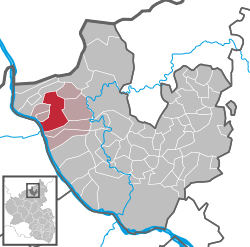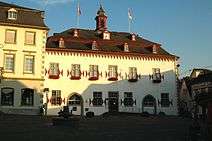Linz am Rhein
| Linz am Rhein | ||
|---|---|---|
| ||
 Linz am Rhein | ||
Location of Linz am Rhein within Neuwied district  | ||
| Coordinates: 50°34′13″N 07°17′05″E / 50.57028°N 7.28472°ECoordinates: 50°34′13″N 07°17′05″E / 50.57028°N 7.28472°E | ||
| Country | Germany | |
| State | Rhineland-Palatinate | |
| District | Neuwied | |
| Municipal assoc. | Linz am Rhein | |
| Government | ||
| • Stadtbürgermeister | Adi Buchwald (CDU) | |
| Area | ||
| • Total | 17.98 km2 (6.94 sq mi) | |
| Population (2015-12-31)[1] | ||
| • Total | 5,902 | |
| • Density | 330/km2 (850/sq mi) | |
| Time zone | CET/CEST (UTC+1/+2) | |
| Postal codes | 53545 | |
| Dialling codes | 02644 | |
| Vehicle registration | NR | |
| Website | www.linz.de | |
Linz am Rhein (in English Linz on the Rhine) is a municipality in the district of Neuwied, in Rhineland-Palatinate, Germany. It is situated on the right bank of the river Rhine near Remagen, approx. 25 km southeast of Bonn and has about 6,000 inhabitants. It is the sister city of Marietta, Georgia in the United States, Linz in Austria and Pornic in France.
Linz is the seat of the Verbandsgemeinde ("collective municipality") Linz am Rhein.
The town is also a destination for tourists thanks to its location next to the Rhine river and its colorful half-timbered houses.

History
The town of Linz was first mentioned in an official document in 874 and called "Lincesce".
Between 1206 and 1214 the parish church of St. Martin was built at the most elevated spot of the town. A former church, which was located at the same place, had been destroyed during the fights of Otto IV and Philip of Swabia in 1198. During reconstruction work in 1981 the remains of graves and foundations belonging to the former church were found.
The most important political decision for Linz was taken in the late Middle Ages. Between 1304 and 1332 Linz was officially awarded city status by the Archbishop of Cologne, Heinrich II of Virneburg. Shortly after having been declared a "city", the castle Burg Linz was built.
In 1391 a fire destroyed two thirds of the city. In 1475 the Emperor's troops occupied Linz during the Neuss War. The town hall, which is one of the major sights of Linz, was built in 1517.
In 1815, Linz became part of Prussia. One year later in 1816 Linz received the status of a district town ("Kreisstadt"). This status was revoked in 1822 and Linz became part of the Neuwied county.
After the Second World War, Linz became a part of Rhineland-Palatinate in 1946.
In the 1970s the city expanded with the new residential area "Roniger Hof". In 1979 the local hospital was put into service.



Mayors
|
|
Sons and daughters of the town

- Ferdinand von Malaisé (1806-1892); Bavarian General, Educator of King Ludwig III of Bavaria
- Anton Joseph Weidenbach (1809-1871), historian and archivist
- Manfred Bruns (born 1934), Federal Prosecutor at the Federal Court of Justice
- Alex Kempkens (born 1942), fotographer
Notes
- ↑ "Gemeinden in Deutschland mit Bevölkerung am 31. Dezember 2015" (PDF). Statistisches Bundesamt (in German). 2016.
External links
| Wikimedia Commons has media related to Linz am Rhein. |
- (German) Official website
